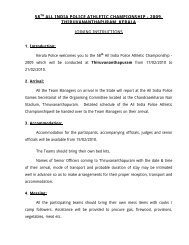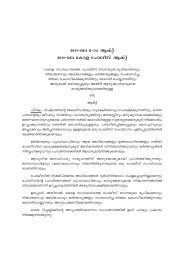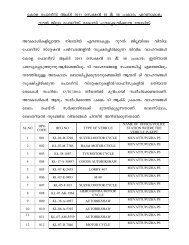Janamaithri Suraksha Project - Kerala Police
Janamaithri Suraksha Project - Kerala Police
Janamaithri Suraksha Project - Kerala Police
Create successful ePaper yourself
Turn your PDF publications into a flip-book with our unique Google optimized e-Paper software.
wardens supplemented the resources of the police in checking minor traffic offences. The sense<br />
of security of the general public increased and the gap between public and police narrowed down<br />
(Trozanowicz, Bayley, Peel).<br />
b) Overall Heightened Sense of Security<br />
With <strong>Janamaithri</strong> <strong>Suraksha</strong> <strong>Project</strong> the residents got an opportunity to closely interact with<br />
the beat police officer, know him by name and face and could freely interact with him during house<br />
visits. The house visits by the beat officer facilitated the process of familiarity. Residents felt that<br />
the police is just a call’s away at the time of need and would definitely respond to their calls. This<br />
resulted in a conscious awareness of safety in the neighborhood. People perceived that the crime<br />
has gone down, though statistics proves otherwise, streets have become safer and anti-socials<br />
elements are scared of the police.<br />
c) Security for the vulnerable section<br />
The <strong>Janamaithri</strong> <strong>Suraksha</strong> <strong>Project</strong> advocated pro-active engagement of the community<br />
police officer with the senior citizens, women, students, destitute, slum dwellers etc. of the area<br />
so that their sense of security is improved. The students through a programme called, Student<br />
<strong>Police</strong> Cadet, are being groomed to be responsible citizens of the future. Some of the issues like<br />
domestic violence, alcoholic abuses etc. are being resolved by the beat police officers as alternative<br />
dispute redressal mechanism. <strong>Police</strong> in return has earned the much needed respect, good will<br />
and trust of the people making its job easier.<br />
d) <strong>Police</strong> mediation in availing basic services<br />
A beat police officer by close interaction with residents of his Beat not only earns their good<br />
will and trust but is perceived as the visible representative of the state in addition to the common<br />
adage of being the strong arm. Residents of the Beat during their interaction bring various nonpolice<br />
related issues to the notice of the Beat Officer, for example, lack of civic amenities like nonavailability<br />
of street lights in the locality, irregular supply of drinking water, problems of solid waste<br />
management etc. The Beat officer intervenes in such instances as they believe that lack of the<br />
basic civic amenities and dumping of waste in a locality has the potential to lead to law and order<br />
situation. Besides, they want to win the goodwill and trust of the residents they serve, thereby<br />
developing a symbiotic relationship with the residents.<br />
e) Empowerment of constabulary<br />
The Beat Officers under <strong>Janamaithri</strong> scheme are mostly from the ranks of Constable and<br />
Head Constable. They comprise the bottom of the police hierarchy, suffer from low motivation,<br />
lack initiatives and are never been part of the decision making process. <strong>Janamaithri</strong> provided the<br />
opportunity to the Beat Officers the much needed visibility, recognition, respect and self-esteem<br />
and in the process empowered the constabulary. By introduction of linking pin structure in the<br />
department, it led to greater organisational commitment and job satisfaction among the lower level<br />
police officers (Choudhury).<br />
f) Institutionalization<br />
<strong>Janamaithri</strong> <strong>Suraksha</strong> <strong>Project</strong> culminated as a flagship community policing scheme of<br />
<strong>Kerala</strong> <strong>Police</strong> after almost after a decade long committed efforts of the police leadership. Starting<br />
from enlisting political consensus for the scheme to publication of Government Order and finally<br />
making legal provision in the new <strong>Kerala</strong> <strong>Police</strong> Act, the process of institutionalization has been an<br />
ongoing process. Uniform and centralized training programme for the Beat Officers, appointment<br />
of a state level Nodal Officer, budgetary provision, publication of standard operating procedure in<br />
shape of <strong>Police</strong> Circular Order and increase in the sanctioned strength of the staff in <strong>Janamaithri</strong><br />
police stations are some of the processes to institutionalize the scheme in the State.<br />
1.5. Policy Context- Process- Outcome Matrix<br />
After having articulated the key findings in the preceding section, a Model has been<br />
conceptualized by triangulating the theories and praxis and organising them in a Context-Process-<br />
Outcome framework in respect of pre-implementation, implementation and impact phases to serve<br />
as guidelines for both the policy makers and implementers in their efforts to introduce community<br />
policing as a public policy.<br />
13

















